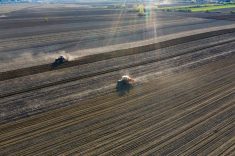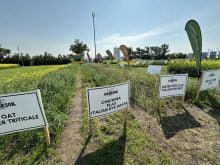With increasing emphasis on soil health these days, there are lots of different tests and parameters for measuring it. But just how important are they?
Perhaps not as important as you think, according to Andrew McGuire, a cropping systems agronomist with the Washington State University extension program. He believes there’s an overemphasis on tests for evaluating soil health and farmers may be better off looking at their soil another way.
For McGuire, that begins with determining if you have a real problem with your soil and, if you do, what exactly is it? He says if farmers are able to identify problems and take actions to solve them, it’s a better strategy than pursuing the fuzzy notion of soil health.
Read Also

Claas brings 1000 Series SP forage harvesters to Canada
In mid-August, Claas unveiled its new line of Jaguar forage harvesters at an event in Visalia, California, deep in the heart of that state’s dairy region.
“Farmers should really think about the problems they’re trying to address, rather than just assuming they need to build soil health,” he says. “That would be the first step in what I term sensible soil health.”
McGuire says a fundamental problem with lab-based soil health evaluation is while some soil health indicators can provide an accurate picture of a soil’s biological and chemical properties, they may have little to do with how well the soil functions.
“Many of the soil health indicators are only marginally linked to some of these problems. I believe some of those indicators do have some value. For example, aggregate stability is definitely related to infiltration. But then there are other ones that are not,” he says.
“You know, some people are measuring their fungal-to-bacterial ratio (the ratio of fungi to bacterial biomass in soil). What exactly is the problem they’re trying to measure here?”
McGuire encourages farmers to try a problem-based soil evaluation approach if they’re concerned about the state of their soil. “I think you avoid some of those issues if you really focus on the problem, and then indicators that are directly related to that problem,” he says.
For McGuire, the true value of this kind of approach is it enables producers to identify specific problem areas they can attack directly, and it can also help guide their management decisions.
McGuire says farmers can start by asking themselves, “What is my soil doing that I don’t want it to do, or what should it be doing that it’s not?” To help farmers with that, McGuire offers a list of questions as shown in Figure 1.

Originally posed by Caley Gasch, a soil scientist with North Dakota State University, McGuire’s questions have been modified so they’re ranked in order from highest to lowest in terms of a problem’s long-term consequences, harmful effects and responsiveness to management.
Question number 1 is about wind and water erosion while the second and third questions address how well your soil handles moisture at the surface (infiltration) and below the surface (drainage). Question number 4 is about surface crusting, while the fifth and sixth questions are about nutrient cycling and soil-borne pests and diseases, respectively.
By answering these questions, farmers will get a better sense of whether they should consider the soil in their fields to be healthy or not. If there aren’t any problems, then it’s likely a good assumption you have good soil health, says McGuire.
“If you don’t have those problems, then you have to start wondering what do you want to gain by going down the soil health path? What kinds of benefits do you want to see?”
According to McGuire, the questions cover the most common problems farmers face, but not all of them. Some of the problems may be related to each other and, if they are, he urges farmers to try to determine what they have in common and ask more questions to get to the root of the problem.
One example is how poor infiltration and excessive erosion by wind may be caused by poor soil structure, but the bigger question is what’s causing the soil structure problem? It could be too much tillage, too little soil organic matter near the surface, or something else. McGuire says the important thing is to keep digging until you have your answer.
Erosion always primary concern
McGuire has some useful tips for farmers on how to practice sensible soil health. In his view, erosion — whether it’s water or wind — is always concern No. 1. “The baseline for soil health is that your soil is not eroding in one way or another, because erosion is going backwards and you’re trying to go forward. So, the first thing is to address erosion.”
McGuire recommends practices like reduced tillage, using cover crops and increasing residue on soil surfaces since they’re not only good for reducing or eliminating erosion but they benefit other aspects of soil health as well. As he points out, these practices also improve a soil’s physical characteristics by improving infiltration and drainage and reducing surface crusting.
Building up soil organic matter not only helps with nutrient cycling but it can fix a lot of problems, particularly if it’s close to the soil surface, says McGuire.
“If the residue is on top of that soil surface, you’ve got the best system of all because it’s going to intercept some of that falling water and break its fall, not letting it impact the ground directly. Then you won’t have some of those infiltration problems and compression problems,” he says.
McGuire maintains by minimizing tillage, “you get that concentration of carbon or organic matter at the soil surface where it’s going to do the most good. It’s very important for forming those stable aggregates that are all held together by glues produced by the biology, the fungi and the bacteria.
“Most of your biological activity is going to be in that top three inches to six inches and that’s where you need the carbon to support that biological activity,” McGuire adds. “You really want to concentrate on that. You don’t want to till it way down deep unless you’re getting paid to sequester carbon,” he adds.
“I tell people they really need to separate carbon sequestration from building soil organic matter because these are two different things. If you’re getting paid to sequester carbon, then putting (residue) down deep may make sense. But if it’s soil building and soil health you’re after, then leaving it right on the surface or very close to the surface makes more sense.”
In instances where soil compaction is a serious problem, tillage may be the only answer, McGuire says.
“You’re going to reduce some compaction just by that freeze-thaw action, especially towards the surface. But if you get deep compaction, and this is usually caused by large equipment driving on wet ground, that’s going to require tillage to fix it,” he says.
“You have to wait until it’s dry to break it up. You can’t till a wet soil and expect to alleviate compaction,” McGuire adds. “I think most farmers are probably aware of the practices that cause compaction, but it’s one of those things that is better to avoid than to try to address afterwards because it’s not easy to do.”















